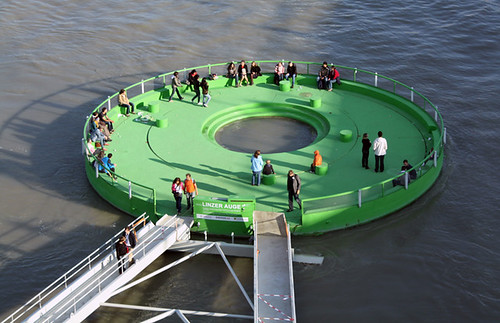Ars Electronica.5
Many long-term public artworks were up throughout Linz during the Ars Electronica Festival. Several are still in place:
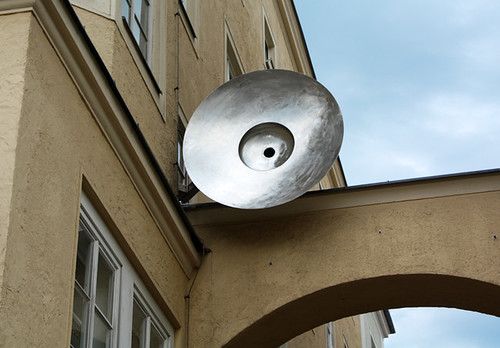
One of the horns linked to the Akustikon. Photo Bruce Charlesworth
The Akustikon is a center for acoustic research that sponsors Acoustic City, which has established several projects throughout the city. Mounted to several buildings in streets nearby are large ear trumpets that link sound back to the Akustikon via metal tubes affixed to the sides of buildings. The tubes converge in a small curtained room where you can eavesdrop on the Hauptplatz and two other outdoor locations. There are a number of interesting indoor audio exhibits in the Akustikon space, particularly a room containing hundreds of small drawers of banned music and sound that play when opened.
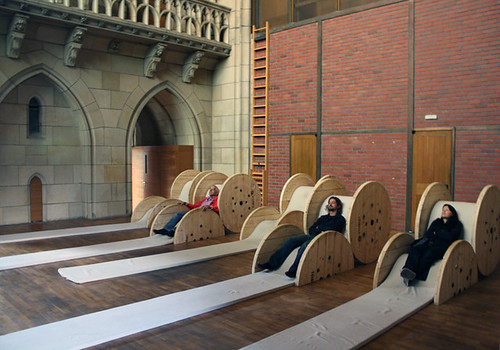
Detail of Ruhepol Mariendom. Photo: Colleen Ludwig
Acoustic City is also responsible for two refuges of quiet in the city. These casual but impressive rehabs of existing spaces are strictly enforced silent zones. Ruhepol Centralkino is a 1950s former movie house with an enormous oval-shaped theater and curved concrete walls. Inside, the walls are hung with plywood boards. A single window above lights the room, augmented by small hanging incandescent bulbs. After taking off your shoes, you can sit on stuffed canvas recliners. Afterward you can have self-serve tea in the lobby. At Ruhepol Mariendom, in the 19th Century gothic revival Linz Mariendom (St Mary’s Cathedral), visitors sit in padded chairs made from giant spools and silently contemplate a stained glass rosette window above.
Floating on the river below the Ars Electronica Center is Das Linzer Auge (The Linz Eye), sponsored by the city as a permanent installation. The circular green structure is made up of two concentric rings that rotate in opposite directions, powered by the Danube’s current. During the week of Ars Electronica, this small artificial island was not operational, but still accessible via one of its walkways.
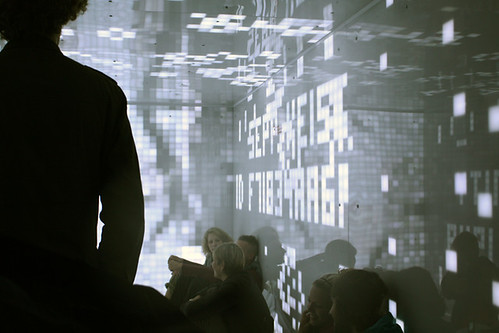
etoy, Mission Eternity. Photo Bruce Charlesworth
On top of the new extension to the Ars Electronica Center was the Mission Eternity sarcophagus by the art collective, etoy. A modified cargo container, its interior walls, floor and ceiling are lined with an LED screen within which people can walk. It displays the “Arcanum Capsul” content, a digital portrait of a pioneer of the information age. Visitors can access this content via their mobile phones or a web browser. This strikingly beautiful piece is part of a convoluted long-term project that is best described on etoy’s website and this movie link: etoy. Mission Eternity. Ars Electronica, 2009.
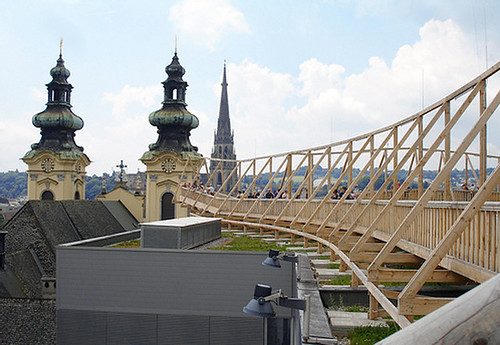
Atelier BowWow, Detail of Super BraNch. Photo: Offenes Kulturhaus
The roof of the Offenes Kulturhaus (OK) supports a number of long-term installations, comprising an exhibition called HÖHENRAUSCH (Thrill of the Heights). A series of wooden stairways and walkways lead up from the art museum and branch out over the rooftops. Atelier Bow-Wow designed this Linz Super BraNch, which cantilevers out at the edges of the roof and gives a panoramic view of the city. The path winds across and over a roof garden planted with unusual vegetation amongst air vents and heating ducts. Artist Werner Pfeffer has set up vantage points and panorama boards along the walkway that tell of people who lived and worked nearby. At several “audio points” you can hear the sounds of trams and church bells. Also included in this show is a 1960s era Ferris wheel repainted by Maider Lapez and a version of Paul DeMarinis’ Rain Dance, which uses showers of water to convey music through the resonance bodies of open umbrellas. On the roof of the former Ursuline Covent next to OK is a medicinal herb garden laid out by Taiwanese artist Mali Wu, who also supplies herbal recipes from diverse fields of knowledge as a part of this installation.
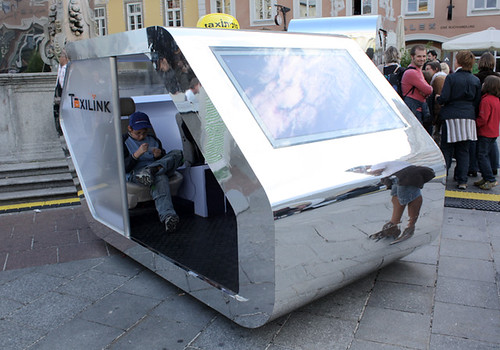
TaxiLink. Photo Bruce Charlesworth
Near the 80+1 pavilion in the Hauptplatz were several networked projects. Sabine Haerri and Yvonne Weber created Movement & Impact as an outdoor couch. Traffic sensors in the congested Gotthard Tunnel in Switzerland send data in real-time to the couch, conveying various sensations to the viewer sitting or lying on the vibrating platform. The TaxiLink project by Lila and Alon Chitayat is a direct video/audio link from a static booth to a taxi as it drives throughout Jerusalem. “Passengers€ can take a live trip through the old city of Jerusalem, and can interact with the cabdriver.
_____________
The standout art museum show during Ars Electronica was “See This Sound” at the Lentos Kunstmuseum, a dense, beautifully mounted survey of sound used from a visual perspective from the 1920s to the present. Human Nature at Brucknerhaus had the atmosphere of a trade show, but contained many thought-provoking works amongst others of dubious interest.
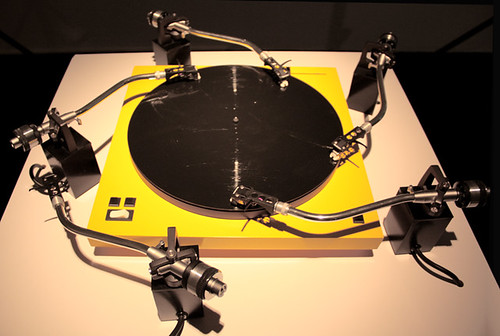
One of Yuri Suzuki's record players. Photo Bruce Charlesworth
The CyberArts show at OK was uneven, with too many artworks identified by the curators as interactive that clearly were not. It was also disappointing and often puzzling that some works appeared only in documentation, such as the DNA hybrid between Eduardo Kac and a petunia. The most interesting works in this show were Lawrence Malstaf’s artificial storm chamber, Nemo Observatorium; Earthstar by David Haines and Joyce Hinterding, which, via radio bursts from the sun, bridges images of the sun’s chromosphere with ozone-like aromas; Perpetual Storytelling Apparatus by Benjamin Maus and Julius von Bismarck, in which a plotting machine draws images taken from a database of patents and makes spontaneous content associations from one to the next; and Yuri Suzuki’s The Physical Value of Sound, a series of very cool interactive record players.
Related
